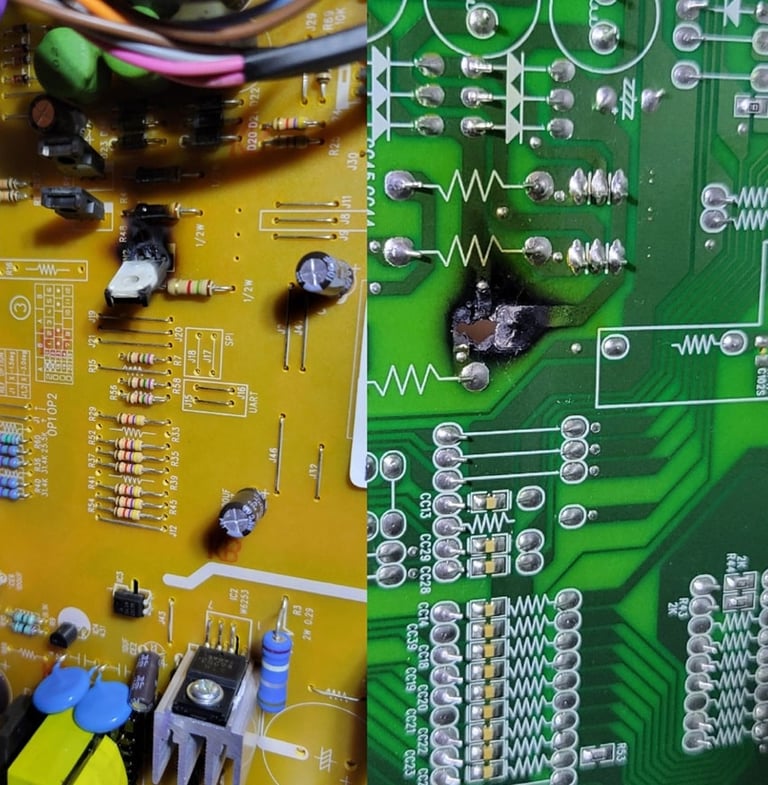If you tinker with appliances yourself, you already know the cheap fixes (clean lint traps, replace hoses, tighten a loose wire). But when the problem is a printed circuit board, the little “brain” that runs your refrigerator, washer, dryer, oven or dishwasher, most people hit a decision point: buy a new board, replace the whole appliance, or have the board repaired by a specialist. In many cases, taking the faulty board to a local master who repairs boards is the smartest, most cost effective path.
Circuit Board Repair


Why repair the board instead of replacing it?
Pros
Cost: Repairing a board is usually far cheaper than buying a new OEM board, and almost always cheaper than replacing an entire appliance. Typical appliance repairs nationwide average in the low hundreds of dollars, far below the price of many OEM electronics.
Speed: A good board repair shop can often diagnose and fix a PCB faster than ordering a special order replacement part.
Sustainability: Fixing electronics keeps perfectly good cabinetwork, motors and compressors out of the landfill.
Preserve old models: For discontinued models, or high end units whose boards are long back ordered repairs can be the only practical option.
Cons
Diagnosis risk: Boards are often blamed for problems that are actually caused by other parts (sensors, relays, compressors). If a shop only replaces the board without thorough testing, you may pay for a fix that isn’t the real solution. Always ask for diagnostic steps and test results.
Not always permanent: If the board failed from a systemic issue (power surge, short, moisture), the repaired board might fail again unless the root cause is fixed.
Warranty limits: Some shops offer short warranties on repairs; OEM parts often carry longer coverage. Ask how long the repair warranty lasts and what it covers.
Cost vs. age: If the appliance is old and other expensive parts are likely to follow, repair may only postpone replacement.
What commonly causes control board failure?
Repair centers and parts houses report the same recurring themes: electrical surges and unstable power, moisture and condensation inside cabinets, overheating due to blocked vents or failing components, age or wear of electrolytic capacitors, and occasional manufacturing defects or poor soldering. Many repair writeups emphasize that surge events and moisture are the two biggest preventable causes.
Which appliances and brands see control board problems most often?
Appliance types: Refrigerators and built in microwaves show up in consumer surveys with relatively high rates of control panel or circuit board complaints, consumer reports and similar surveys list “broken or faulty control panel/circuit board” among the top specific failure modes for kitchen appliances (around 5% in some national surveys). That doesn’t mean every fridge will fail, only that panel/board faults are a common single complaint. - "Consumer Reports".
Brands: Wide, brand level statistics specifically isolating control board failures (as opposed to overall reliability) are scarce from repair shops, because shops track symptoms and parts differently. Broad reliability surveys and repair industry summaries do identify certain brands that historically require more service calls for modern, feature heavy refrigerators (for example, some recent surveys and repair industry reports have shown higher service rates reported for certain large electronics brands). Use these reliability rankings as a guide, but treat brand board statistics cautiously, the model, installation, and environment matter a lot. - "Yale Appliance BlogPrudent Reviews".
Short form: Boards commonly fail in fridges and found in walls microwaves; brand level control board percentages from large repair chains are not usually published in a clean, comparable way are reputable surveys (Consumer Reports, industry reports) provide the best public figures. If you need exact brand/model vulnerability for a specific unit, ask the repair shop to check their service history for that model.
What to ask before leaving the board on repair
Diagnostic report: Ask for a written diagnosis explaining why they think the board is the cause and what tests were performed. (Good shops will test other components first, because boards are commonly misdiagnosed.) Repair Clinic
Repair procedure & parts: Will they replace capacitors, connectors, relays, or micro controllers? Do they use conformal coating if moisture caused the failure?
Warranty: How long is the repair guaranteed? What’s covered if the same fault recurs?
Root cause analysis: If the failure was a surge or moisture, will they advise on fixes or preventive upgrades?
Cost estimate vs. replacement: Get a clear line item estimate (diagnostic fee, labor, parts) and compare it with the price of a new OEM board and the cost of a new appliance. Typical repair bills fall in the low to mid hundreds, whereas an OEM board or a new appliance will often be several hundred to thousands more.

Prevention tips
Surge protection: Plug heavy appliances into whole home surge protection or at least a dedicated, high quality surge protector.
Keep it dry and ventilated: Ensure dishwasher and washer seals are healthy; keep refrigerator coils clean and give electronics breathing room.
Routine maintenance: Clean vents, check door seals, and replace failing motors or pumps early, a failing motor can overheat and stress its control board.
@aspecoappliancerepair
Services
Aspeco
Mon-Sun
8:00am - 7:00pm
Contacts
Business hours




